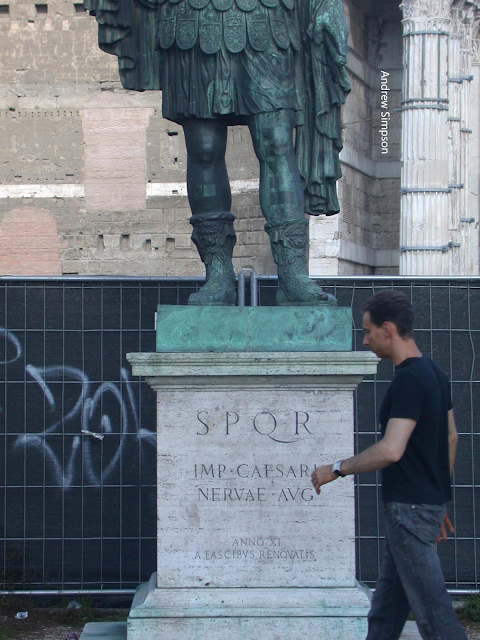So, what is it about the need some people have to write on walls?
 |
| Bits that escaped the scribblers, Rome, 2007 |
Now I am not thinking about the spray can artists who emblazon their name, tag or other bewildering message across buildings, buses, and urinals, although they do puzzle me.
No, it’s those who feel the need to carve their name, or initials on an ancient monument, as if that somehow enhances this relic of the past or ensures the scribbler some eternal longevity.
.jpg) |
| Bits that might yet attract scribblers, 2007 |
They won’t have been the first nor the last, but what marks them out is that they were caught in the act and were filmed by angry fellow tourists.
The response of the two when caught were different. According to reports I have read the British defacer claimed he didn’t know the history or the significance of the Colosseum while the Swiss girl just shrugged, and her parents appeared to think there was nothing wrong.
I guess some will mutter “so what, get a grip, it’s no big deal”, and it is true that leaving a message is not new.
Roman soldiers carved their name on bits of the Sphinx in Egypt only to be followed by French and British soldiers during the Revolutionary and Napoleonic Wars, and no doubt there will be a broken-down monument in Iraq that bears an inscription from members of the Coalition forces.
The historian in me can even see how some of those ancient acts of vandalism are now themselves part of the historic story.
 |
| Replica statue of Emperor Augustus, 2007 |
The poignant carved messages by prisoners in the Tower of London offer an insight into the plight of the innocent and not so innocent who fell foul of a change in dynasty or official religious policy.
While the political slogans and obscene suggestions left on the walls of Pompeii reminds us that electioneering promises are not new, and the humour and ingenuity of some scribblers can be as funny now as they were in 79 AD.
 |
| Prisoners inscriptions Beauchamp Tower 1553-1622** |
But maybe just maybe that’s hogwash, and really writing your name on an ancient monument is just vanity and an act of vandalism ranking alongside the lopping off of bits of Greek and Roman statues.
Rant over.
Location; Rome and London
 |
| And the replica of Emperor Nervae who didn't escape the scribbler, 2007 |
Pictures; bits of Rome that have survived and a few new bits, 2007-2010 from the collection of Andrew Simpson and Prisoners inscriptions Beauchamp Tower, 1553-1622, from The Tower of London HMSO, 1967
*Marcus and Flavia ....... true love forever
**Prisoners inscriptions on the walls of the Beauchamp Tower, left T Salmon, 1622, centre the Dudley Brothers, 1553, right, G. Gifford, 1586
No comments:
Post a Comment